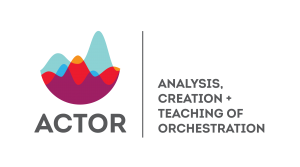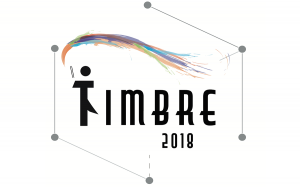Analysis, Creation and Teaching of Orchestration
Orchestration, taken in its broadest sense, is the judicious selection, combination, and juxtaposition of musical instruments and sound effects to achieve a desired musical goal. It sculpts the complex set of auditory qualities known collectively as “timbre” or “sound colour,” which immediately engages listeners of all types of music from concerts to cinema to video games and contributes to the music’s sense of identity. Although orchestration practice and pedagogy traditions have been developed since the mid-19th century, we lack the development of a theory that explains, using recent advances in cognitive science and technology, how and why certain orchestration techniques work, what their perceptual effects are, and how they induce an emotional response in listeners. Orchestration is a ubiquitous, but understudied, aspect of music that is worth understanding more deeply as it is crucial to grasping human/music interaction and providing tools for creative musical thought.
The first goal of the Analysis, Creation and Teaching of Orchestration (ACTOR) Partnership is therefore to acquire knowledge of orchestration practice and of the resulting perception by listeners to develop a theory grounded in perception and cognition.
This knowledge base will be integrated into a first-of-its-kind, open-access interactive database for exploration by scholars and practicing musicians, and will include machine-readable scores, analyses of scores, recordings, writings and interviews with composers and conductors, acoustic analyses of musical excerpts, and results of perceptual experiments with listeners. The knowledge will also be integrated into new tools to enhance musical creativity by applying it to:
- a computer-aided orchestration environment for finding innovative solutions to combining instrument sounds, and
- an online pedagogical resource with which scholars, musicians and music lovers can explore the various aspects of orchestration interactively.
The tools will facilitate the education of this complex set of skills for young musicians, composers, arrangers, orchestrators and sound designers by providing an interactive environment that associates score representations with musical results. These tools will also be applied to education and the mobilization of new knowledge through didactic applications on mobile devices and live shows with orchestras for school-aged children and the general public. Music scholarship will be transformed by the partnership through both the application of novel analytical tools that mine the content of the database to uncover the untheorized mysteries in over four centuries of music, and the development of sound-based music analysis tools that can be applied to unnotated musics, as well as directly to recordings of notated music.
The aim of this 7-year ACTOR Partnership, including 13 academic, 1 public-sector and 5 private-sector partners, is to develop a broad set of tools and methods for scholars and practitioners that do not exist at present and to revolutionize music creation, music education and music scholarship in the realms of orchestration and of timbre perception and production.
Partnership Overview
| Project Director | Stephen McAdams | McGill University |
|---|---|---|
| Co-applicants | Aristotelis Hadjakos | Hochschule für Musik Detmold |
| Caroline Traube | Université de Montréal | |
| Catherine Guastavino | McGill University | |
| Eliot Britton | University of Toronto | |
| Emily Dolan | Harvard University | |
| Eric Daubresse | Haute école de musique de Genève | |
| Friedemann Sallis | University of Calgary | |
| Ichiro Fujinaga | McGill University | |
| Jean-Francois Rivest | Université de Montréal | |
| Jeffrey Boyd | University of Calgary | |
| John Rea | McGill University | |
| Keith Hamel | The University of British Columbia | |
| Laurie Radford | University of Calgary | |
| Malte Kob | Hochschule für Musik Detmold | |
| Martha de Francisco | McGill University | |
| Mathieu Schneider | Université de Strasbourg | |
| Norbert Palej | University of Toronto | |
| Patrick Susini | Centre national de la recherche scientifique | |
| Philippe Depalle | McGill University | |
| Philippe Esling | Université Pierre et Marie Curie (Paris VI) | |
| Rand Steiger | University of California, San Diego | |
| Robert Hasegawa | McGill University | |
| Robert Pritchard | The University of British Columbia | |
| Roger Reynolds | University of California, San Diego | |
| Ryan McClelland | University of Toronto | |
| Victor Cordero | Haute école de musique de Genève | |
| Yan Maresz | Consérvatoire national supérieur de musique et de danse de Paris | |
| Zachary Wallmark | Southern Methodist University | |
| Collaborators | Alex Rehding | Harvard University |
| Axel Berndt | Hochschule für Musik Detmold | |
| Carlos Agon | Science and Technology of Music and Sound – UMR 9912 | |
| Chaya Czernowin | Harvard University | |
| Cynthia Leive | McGill University | |
| David Eagle | University of Calgary | |
| Denys Bouliane | OrchPlayMusic Inc. | |
| Donald McLean | University of Toronto | |
| Ellen Lockhart | University of Toronto | |
| Fabien Lévy | University of Music and Theatre „Felix Mendelssohn Bartholdy“ Leipzig | |
| Félix Frédéric Baril | OrchPlayMusic Inc. | |
| Frank Russo | Ryerson University | |
| Geraldine Aliberti | Sonic Solveig | |
| Gerard Assayag | Science and Technology of Music and Sound – UMR 9912 | |
| Goffredo Haus | Università degli Studi di Milano | |
| Gregory Lee Newsome | University of Toronto | |
| Guillaume Bourgogne | McGill University | |
| Hans Tutschku | Harvard University | |
| Jean-Michaël Lavoie | Université de Montréal | |
| Lasse Thoresen | Norwegian Academy of Music | |
| Luis Naon | University of Applied Sciences and Arts Western Switzerland | |
| Marc-Pierre Verge | Applied Acoustics Systems | |
| Markus Noisternig | Institut de recherche et coordination acoustique/musique | |
| Meghan Goodchild | Queen’s University | |
| Michael Jarrell | University of Applied Sciences and Arts Western Switzerland | |
| Michael Tenzer | The University of British Columbia | |
| Miller Puckette | University of California, San Diego | |
| Nicolas Donin | Science and Technology of Music and Sound – UMR 9912 | |
| Olivier Warusfel | Institut de recherche et coordination acoustique/musique | |
| Philippe Leroux | McGill University | |
| Pierre Michaud | Université de Montréal | |
| Pierre Michel | Université de Strasbourg | |
| Robert Normandeau | Université de Montréal | |
| Shahrokh Yadegari | University of California, San Diego | |
| Sherry Lee | University of Toronto | |
| Yoshua Bengio | Université de Montréal | |
| Partners | Applied Acoustics Systems | Montréal, QC |
| Calcul Québec | Montréal, QC | |
| Consérvatoire national supérieur de musique et de danse de Paris | France | |
| Harvard University | Cambridge, MA | |
| Haute école de musique de Genève | Switzerland | |
| Hochschule für Musik Detmold | Germany | |
| Institut de recherche et coordination acoustique/musique | France | |
| Orchestre symphonique de Montréal | Montréal, QC | |
| OrchPlayMusic Inc. | Carignan, QC | |
| Sonic Solveig | France | |
| Southern Methodist University | Dallas, TX | |
| The University of British Columbia | Vancouver, BC | |
| Université de Montréal | Montréal, QC | |
| Université de Strasbourg | France | |
| University of Calgary | Calgary, AB | |
| University of California, San Diego | La Jolla, CA | |
| University of Toronto | Toronto, ON | |
| Vibe Avenue | Montréal, QC |



